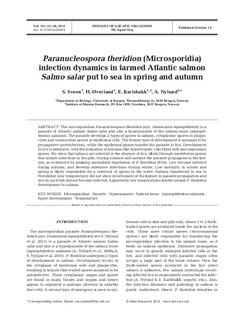| dc.contributor.author | Sveen, Silje | |
| dc.contributor.author | Øverland, Hanne | |
| dc.contributor.author | Karlsbakk, Egil | |
| dc.contributor.author | Nylund, Are | |
| dc.date.accessioned | 2012-11-29T10:17:19Z | |
| dc.date.issued | 2012-10-10 | |
| dc.identifier.issn | 0177-5103 | |
| dc.identifier.issn | 1616-1580 | |
| dc.identifier.uri | http://hdl.handle.net/11250/109246 | |
| dc.description.abstract | The microsporidian Paranucleospora theridion (syn. Desmozoon lepeophtheirii) is a
parasite of Atlantic salmon Salmo salar and also a hyperparasite of the salmon louse Lepeophtheirus
salmonis. The parasite develops 2 types of spores in salmon, cytoplasmic spores in phagocytes
and intranuclear spores in epidermal cells. The former type of development is assumed to be
propagative (autoinfection), while the epidermal spores transfer the parasite to lice. Development
in lice is extensive, with the formation of xenoma-like hypertrophic cells filled with microsporidian
spores. We show that salmon are infected in the absence of lice, likely through waterborne spores
that initiate infections in the gills. During summer and autumn the parasite propagates in the kidney,
as evidenced by peaking normalised expression of P. theridion rRNA. Lice become infected
during autumn, and develop extensive infections during winter. Lice mortality in winter and
spring is likely responsible for a reservoir of spores in the water. Salmon transferred to sea in
November (low temperature) did not show involvement of the kidney in parasite propagation and
lice on such fish did not become infected. Apparently, low temperatures inhibit normal P. theridion
development in salmon. | no_NO |
| dc.language.iso | eng | no_NO |
| dc.publisher | Inter-Research | no_NO |
| dc.subject | salmon lice | no_NO |
| dc.subject | lakselus | no_NO |
| dc.subject | temperature | no_NO |
| dc.subject | temperatur | no_NO |
| dc.title | Paranucleospora theridion (Microsporidia) infection dynamics in farmed Atlantic salmon Salmo salar put to sea in spring and autumn | no_NO |
| dc.type | Journal article | no_NO |
| dc.type | Peer reviewed | no_NO |
| dc.subject.nsi | VDP::Agriculture and fishery disciplines: 900::Fisheries science: 920::Resource biology: 921 | no_NO |
| dc.subject.nsi | VDP::Agriculture and fishery disciplines: 900::Fisheries science: 920::Aquaculture: 922 | no_NO |
| dc.subject.nsi | VDP::Social science: 200::Library and information science: 320::Knowledge retrieval and organization: 323 | no_NO |
| dc.description.embargo | 2017-10-10 | |
| dc.source.pagenumber | 43-49 | no_NO |
| dc.source.volume | 101 | no_NO |
| dc.source.journal | Diseases of Aquatic Organisms | no_NO |
| dc.source.issue | 1 | no_NO |
| dc.identifier.doi | http://dx.doi.org/10.3354/dao02464 | |
